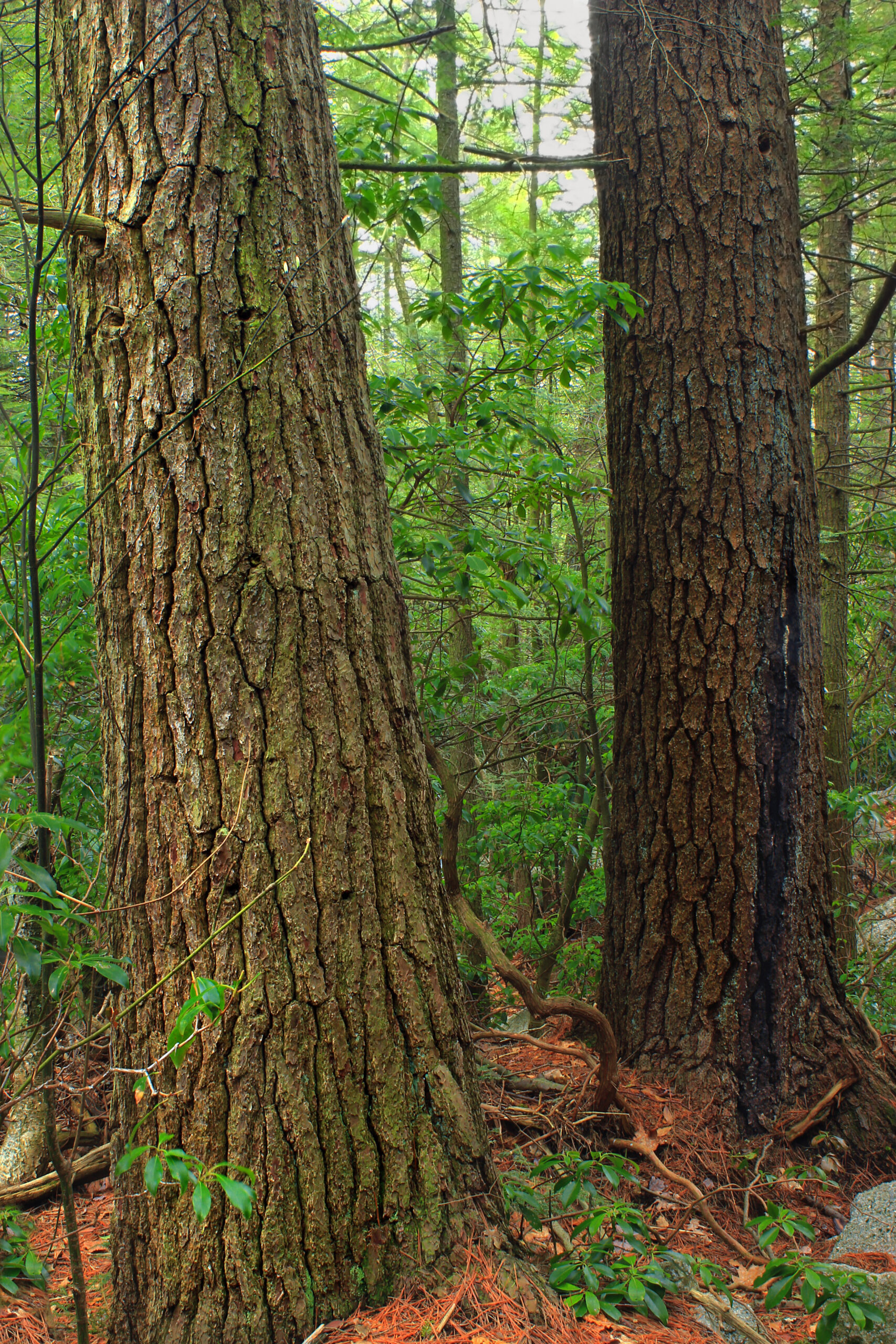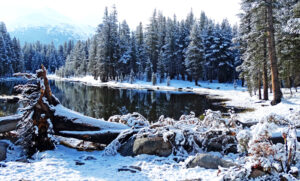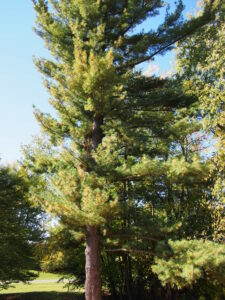Eastern White Pine
Overview
The Eastern White Pine is a towering icon of Eastern North America’s forests, revered for its timber and stately presence. With feather-like leaves and a classic pyramid shape, this conifer thrives in a wide range of climates, offering both practical and aesthetic advantages. Though easy to cultivate, the Eastern White Pine contends with certain pests and diseases, yet it remains a resilient feature of the natural landscape and a living slice of history.

Characteristics
Known for its towering height, pyramidal shape, and significant contributions to the lumber industry.
Region
Found from Newfoundland to northern Georgia and covers growing zones 3 to 8.
Natural Habitat
Found in various terrains including mixed forests, dry ridges, and wet swamps.
Cultivation
Prefers full sun to partial shade, requires moist, well-drained soil, and tolerates a wide range of soil types, including sandy and acidic soils.
Uses and Benefits
Beyond its towering presence in forests and its revered status in the lumber industry, the Eastern White Pine (Pinus strobus) brings a charming utility to various settings. Home gardeners treasure its fine, feathery needles and the open canopy that lends a soft, airy texture to landscapes.
But it’s not just about aesthetics; this magnificent tree has had its share of practical uses too:
- Building Material: Historically, Eastern White Pine wood has been a fundamental building material given its strength and availability.
- Herbal Medicine: Though less documented, some traditions regard the needles as a source of vitamin C and use them to brew a type of tea.1
In this way, the Eastern White Pine weaves a story of both beauty and utility, leaving a green footprint in our history and everyday lives. Its unique features offer multiple benefits:
| Feature | Benefit |
|---|---|
| Fine, feathery needles | Adds a soft, airy texture to landscapes |
| Open canopy | Allows sunlight to reach understory plants |
| Strong, available wood | Serves as a reliable building material |
| Vitamin C in needles | Can be used to brew a nutritious tea |
Whether you appreciate its beauty in your garden or its practical uses, the Eastern White Pine is a valuable addition to any nature-conscious home.

Cultivation Tips
To ensure your Eastern White Pine (Pinus strobus) thrives, start by planting seeds in well-drained soil with a slightly acidic pH, emulating their natural habitat1. These trees are adaptable to various soil types but prefer light, sandy loams. When selecting a spot, consider ample space as they can grow quite tall—80 to 100 feet—and spread out 20 to 40 feet.
Ideal for growing zones 3 to 8, the Eastern White Pine does best with full sun to partial shade and requires regular watering, especially during dry spells. To maintain its health, keep an eye out for common pests and diseases:
- White pine weevil: This insect can cause significant damage to young trees. Monitor for signs of infestation and remove affected branches promptly.
- Needle cast: A fungal disease that causes needles to turn brown and fall off prematurely. Ensure proper air circulation and avoid overcrowding to prevent this issue.
- Root rot: Overwatering or poor drainage can lead to root rot. Ensure the soil drains well and avoid excessive moisture around the tree’s base.
As the Eastern White Pine matures, it requires little maintenance, making it a majestic and enduring addition to your landscape. For smaller spaces, consider dwarf varieties such as ‘Nana’ or ‘Blue Shag’—they offer the same feathery charm without overwhelming your garden4.
With proper care and attention, your Eastern White Pine will thrive and provide year-round beauty for generations to come.
Seasonal Considerations
When planting your Eastern White Pine (Pinus strobus), timing is key. Aim to plant seeds in the fall or early spring when temperatures are cool and moisture is abundant. This will give your seedlings the best chance to establish strong roots before the heat of summer sets in.
As the seasons change, keep these tips in mind:
- Spring: Monitor soil moisture and water deeply if needed. Mulch around the base of the tree to retain moisture and suppress weeds.
- Summer: Provide consistent watering during dry spells, as Eastern White Pines prefer evenly moist soil. Watch for signs of stress, such as yellowing needles or wilting branches.
- Fall: Reduce watering as temperatures cool and rainfall increases. Prune any dead, damaged, or diseased branches to promote healthy growth in the spring.
- Winter: In colder zones, protect young trees from harsh winds and heavy snow by wrapping them in burlap or using stakes for support.
Throughout the year, keep an eye out for common pests and diseases that may affect your Eastern White Pine. The white pine weevil, for example, is most active in the spring and can cause significant damage to young trees1. Regular monitoring and prompt action can help keep your tree healthy and thriving for years to come.

Issues and Troubleshooting
Gardeners and nature enthusiasts often face challenges when caring for the Eastern White Pine (Pinus strobus). Pests, such as the white pine weevil, represent one of the more significant threats. This insect particularly targets the tree’s central shoot, leading to potential damage in the aesthetic form and health of the pine5.
To combat white pine weevil infestations, consider the following tips:
- Regularly inspect your Eastern White Pine for signs of weevil activity, such as wilting or drooping leaders
- Prune and destroy infected leaders in early summer before adult weevils emerge
- Apply insecticides to the terminal leader in the spring to prevent weevil attacks
- Encourage natural predators, like birds and parasitic wasps, by providing them with a welcoming habitat near your pine
In addition to pests, Eastern White Pines may face issues related to environmental stressors. These majestic trees prefer well-drained soils and can suffer in areas with poor drainage or excessive moisture. If you notice yellowing needles or stunted growth, consider improving drainage around the tree’s base and ensuring it receives adequate sunlight.
Keeping an eye out for signs of distress in your Eastern White Pine is key to maintaining its majestic presence. Regular monitoring and prompt action against pests and environmental issues can go a long way in securing the well-being of this beautiful tree. If you notice anything amiss, don’t hesitate to seek guidance from a local arborist or a trusted plant care resource.
History and Folklore
The Eastern White Pine, with its stately presence, whispers tales from a time long before modern memory. This majestic tree, native to the forests of Eastern North America, has watched centuries unfold.
Colonial masts soared across oceans, thanks largely to the vast stands of Eastern White Pine which lined the land3. The tree was not just a witness to history; it was a participant, playing a role in the transformation of landscapes as its timber fueled the growth of a nation.
By the late 1800s, however, the once abundant virgin forests of this noble tree had almost entirely disappeared, a casualty of the insatiable demand for lumber3. This marked a significant turning point in the ecological and cultural history of the region, leaving behind a legacy entwined with the land and its people.
The Eastern White Pine’s influence extends beyond its role in shipbuilding and construction. Native American tribes, such as the Haudenosaunee (Iroquois), revered the tree for its medicinal properties and used its resin to treat various ailments4.
The tree also found its way into folklore and literature. Henry David Thoreau, the renowned American writer and naturalist, celebrated the Eastern White Pine in his works, recognizing its beauty and ecological importance5.
Today, the Eastern White Pine serves as a reminder of the delicate balance between human progress and nature’s resilience. As efforts to restore and preserve this iconic species continue, its history remains forever etched in the annals of the American landscape.
References
1. Eastern white pine | The Morton Arboretum, https://mortonarb.org
2. How to Grow and Care for Eastern White Pine – The Spruce, https://thespruce.com
3. Eastern White Pine – US Forest Service Research and Development, https://srs.fs.usda.gov
4. EASTERN WHITE PINE – PINUS STROBUS | The UFOR Nursery & Lab, https://trees.umn.edu
5. Pinus strobus — eastern white pine – Go Botany, https://gobotany.nativeplanttrust.org
Image Credit: Nicholas_T Attribution License
Image Credit: inkknife_2000 (13.5 million views) Attribution-ShareAlike License
Image Credit: F. D. Richards Attribution-ShareAlike License
Nicolas Duval
Nicolas is a passionate advocate for nature and the art of wildcrafting. His dedication shines through in Wildcraftia, a website he meticulously crafted to serve as a haven for nature enthusiasts worldwide. Driven by a deep appreciation for nature’s connection to humanity, Nicolas embarked on his journey in 2011 with SmokableHerbs, a platform showcasing his love for nature’s bounty. Building upon this foundation, he established Smokably, a thriving online store offering premium herbs and blends to a global audience.
